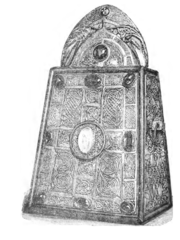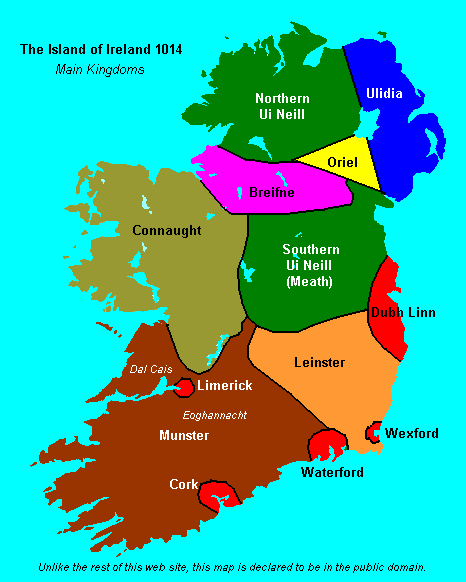
Domhnall MacLochlainn
Encyclopedia

High King of Ireland
The High Kings of Ireland were sometimes historical and sometimes legendary figures who had, or who are claimed to have had, lordship over the whole of Ireland. Medieval and early modern Irish literature portrays an almost unbroken sequence of High Kings, ruling from Tara over a hierarchy of...
.
High Kingship after Máel Sechnaill

Máel Sechnaill mac Domnaill
Máel Sechnaill mac Domnaill , also called Máel Sechnaill Mór, Máel Sechnaill II, anglicized Malachy II, was King of Mide and High King of Ireland...
of Clann Cholmáin
Clann Cholmáin
Clann Cholmáin is the name of the dynasty descended from Colmán Mór , son of Diarmait mac Cerbaill. Part of the Southern Uí Néill — they were the kings of Mide — they traced their descent to Niall Noígiallach and his son Conall Cremthainne.Related dynasties descended through Conall...
, in 1022. Later, rival kings produced differing definitions. Domnall's legal men, for example, claimed that a High King "with opposition" was the king of a province who could lead his army throughout Ireland without defeat, and this Domnall could do. The supporters of his southern rival, Muirchertach Ua Briain of Munster
Munster
Munster is one of the Provinces of Ireland situated in the south of Ireland. In Ancient Ireland, it was one of the fifths ruled by a "king of over-kings" . Following the Norman invasion of Ireland, the ancient kingdoms were shired into a number of counties for administrative and judicial purposes...
, disagreed, and said a High King "without opposition" should control three great port cities of Ireland: Dublin, Waterford
Waterford
Waterford is a city in the South-East Region of Ireland. It is the oldest city in the country and fifth largest by population. Waterford City Council is the local government authority for the city and its immediate hinterland...
, and Limerick
Limerick
Limerick is the third largest city in the Republic of Ireland, and the principal city of County Limerick and Ireland's Mid-West Region. It is the fifth most populous city in all of Ireland. When taking the extra-municipal suburbs into account, Limerick is the third largest conurbation in the...
, cities over which Muirchertach exercised some control.
Regardless of legal fictions, the first king to construct something resembling an overlordship of Ireland after the death of Máel Sechnaill was Diarmait mac Maíl na mBó
Diarmait mac Mail na mBo
Diarmait mac Maíl na mBó was King of Leinster, and also High King of Ireland .He was one of the most important and significant Kings in Ireland in the pre-Norman era...
of the Uí Cheinnselaig
Uí Cheinnselaig
The Uí Ceinnselaig , from the Old Irish "grandsons of Cennsalach", are an Irish dynasty of Leinster who trace their descent from Énnae Cennsalach, a supposed contemporary of Niall of the Nine Hostages...
. Only called King of Leinster
Leinster
Leinster is one of the Provinces of Ireland situated in the east of Ireland. It comprises the ancient Kingdoms of Mide, Osraige and Leinster. Following the Norman invasion of Ireland, the historic fifths of Leinster and Mide gradually merged, mainly due to the impact of the Pale, which straddled...
and the Foreigners in his obituary, Diarmait was more than this, the effective ruler of much of Ireland. His son Murchad ruled Dublin, Toirdelbach Ua Briain in Munster
Munster
Munster is one of the Provinces of Ireland situated in the south of Ireland. In Ancient Ireland, it was one of the fifths ruled by a "king of over-kings" . Following the Norman invasion of Ireland, the ancient kingdoms were shired into a number of counties for administrative and judicial purposes...
was his client, and Niall mac Eochada
Niall mac Eochada
Niall mac Eochada , was king of Ulaid from 1016.His father, Eochada mac Ardgair, died in 1004. His early military ventures were against members of his own sept, Dál Fiatach. He defeated a cousin in 1012 at the ‘battle of the Summits’ and in 1020 defeated and blinded Flaithbertach Ua EochadaIn 1022...
of Ulster
Ulster
Ulster is one of the four provinces of Ireland, located in the north of the island. In ancient Ireland, it was one of the fifths ruled by a "king of over-kings" . Following the Norman invasion of Ireland, the ancient kingdoms were shired into a number of counties for administrative and judicial...
was his ally. Diarmait's career ended with his death in battle, attempting to subjugate the heirs of Máel Sechnaill, on Tuesday 7 February 1072.
Diarmait's position was quickly taken by his former puppet Toirdelbach Ua Briain. Ua Briain installed his son, Muirchertach in Dublin, and campaigned in Ulster. In Leinster and Connacht
Connacht
Connacht , formerly anglicised as Connaught, is one of the Provinces of Ireland situated in the west of Ireland. In Ancient Ireland, it was one of the fifths ruled by a "king of over-kings" . Following the Norman invasion of Ireland, the ancient kingdoms were shired into a number of counties for...
he pursued a policy of setting rival families against each other. Domnall Ua Lochlainn, on his coming to power in 1084, was left undisturbed by Ua Briain, who fell ill the following year and died in 1086, aged 77. At his death, even the partisan northern annals recognised Toirdelbach Ua Briain as king of Ireland.
Origins
Domnall was the son of a certain Artgar son of Lochlann. GenealogicalGenealogy
Genealogy is the study of families and the tracing of their lineages and history. Genealogists use oral traditions, historical records, genetic analysis, and other records to obtain information about a family and to demonstrate kinship and pedigrees of its members...
compilations, such as that surviving in the Rawlinson B.502 manuscript trace Domnall's ancestry back, through the High King Domnall ua Néill
Domnall ua Néill
Domhnall ua Néill was High King of Ireland from 956 to 980.Domnall was the son of Muirchertach mac Néill, and grandson of Niall Glúndub, a member of the Cenél nEógain northern Uí Néill. He became co-King of Ailech with his brother Flaithbertach on the death of his father in 943...
, and his father the heroic Muirchertach of the Leather Cloaks, to Niall Glúndub
Niall Glúndub
Niall Glúndub mac Áedo was a 10th century Irish king of the Cenél nEógain and High King of Ireland. While many Irish kin groups were members of the Uí Néill, tracing their descent from Niall of the Nine Hostages , the O'Neill dynasty took their name from Niall Glúndub rather than the earlier Niall...
. The reality appears to be subtly different as demonstrated by the records in the Book of Leinster
Book of Leinster
The Book of Leinster , is a medieval Irish manuscript compiled ca. 1160 and now kept in Trinity College, Dublin, under the shelfmark MS H 2.18...
. Rather than being the descendants of Lochlann, grandson of Domnall ua Néill, the Mac Lochlainn appear to have be descended from another Lochlann, Lochlann mac Maíl Sechnaíll, a descendant of Niall Glúndub's less renowned brother Domnall Dabaill. Nonetheless, the Mac Lochlainn were members of the Cenél nEógain
Cenél nEógain
Cenél nEóġain is the name of the "kindred" or descendants of Eógan mac Néill , son of Niall Noígiallach who founded the kingdom of Tír Eoghain in the 5th century...
branch of the Uí Néill
Uí Néill
The Uí Néill are Irish and Scottish dynasties who claim descent from Niall Noigiallach , an historical King of Tara who died about 405....
, and could rightly claim famous ancestors, albeit in the 9th century and earlier. Under Domnall, the Cenél nEógain were again a significant force in Irish politics.
In the years before Domnall, the Cenél nEógain had been largely bereft of effective leadership, so much so that Conchobar Ua Briain of Munster, cousin and bitter enemy of Toirdelbach, had been invited to take the kingship of the Telach Óg branch of the kindred, and following Conchobar's murder in 1078, his brother Cennétig was invited to succeed him.
Domnall became king of Ailech in 1083 and began his reign in traditional fashion, with an inaugural raid—crech ríg—against the Conaille Muirthemne (in the region of modern Dundalk
Dundalk
Dundalk is the county town of County Louth in Ireland. It is situated where the Castletown River flows into Dundalk Bay. The town is close to the border with Northern Ireland and equi-distant from Dublin and Belfast. The town's name, which was historically written as Dundalgan, has associations...
, County Louth
County Louth
County Louth is a county of Ireland. It is part of the Border Region and is also located in the province of Leinster. It is named after the town of Louth. Louth County Council is the local authority for the county...
). The Annals of Ulster state that Domnall "carried off a great prey of cattle and gave stipends from that prey to the men of Fernmag [the people and land from whom modern County Fermanagh
County Fermanagh
Fermanagh District Council is the only one of the 26 district councils in Northern Ireland that contains all of the county it is named after. The district council also contains a small section of County Tyrone in the Dromore and Kilskeery road areas....
was named]".
However, a matrilinial kinsman of Toirdelbach, Muirchertach Ua Briain, moved to oppose the rule of Mac Lochlainn between 1101 and 1119.
Death and after
Domnall's glowing obituary in the Annals of UlsterAnnals of Ulster
The Annals of Ulster are annals of medieval Ireland. The entries span the years between AD 431 to AD 1540. The entries up to AD 1489 were compiled in the late 15th century by the scribe Ruaidhrí Ó Luinín, under his patron Cathal Óg Mac Maghnusa on the island of Belle Isle on Lough Erne in the...
reads as follows:
Domnall son of Ardgar son of Lochlann, over-king of Ireland, pre-eminent among the Irish in form and lineage, in sense and valour, in happiness and prosperity, in giving valuables and food, died in Daire Coluim CilleDerryDerry or Londonderry is the second-biggest city in Northern Ireland and the fourth-biggest city on the island of Ireland. The name Derry is an anglicisation of the Irish name Doire or Doire Cholmcille meaning "oak-wood of Colmcille"...
in the thirty-eighth year of his reign, the seventy-third year of his age, on Wednesday night, the fourth of the Ides [i.e. 10 February 1121] and the eighteenth of the moon, the feast of Mo-ChuarócMo Chuaroc moccu Neth SemonMo Chuaroc moccu Neth Semon was an Irish monk and scholar of the Early Middle Ages.He was a native of the Youghal area of what is now County Cork in southern Ireland. He studied with Mo Sinu moccu Min and later recorded what the latter taught, which is thought to have been an ordo numerorum, a...
the wise.

